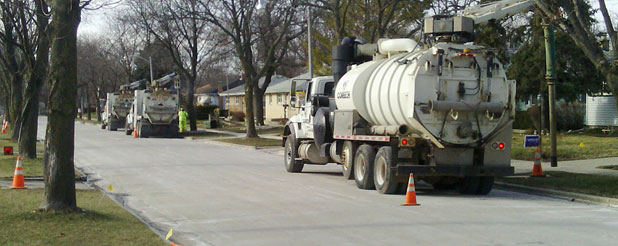What Is Keyholing?
Safely uncover utilities.
Posted 03:51 September 16, 2024
Read 560 times
 Keyholing is a specialized application of hydro excavation that involves creating small, precise excavations to access underground utilities for maintenance, inspection, or repairs. The technique has become increasingly popular in the utility and construction industries due to its minimal impact on the surrounding area and its efficiency in completing tasks with minimal disruption. The use of hydro excavation for keyholing allows for a non-destructive approach to digging, making it particularly effective in urban environments or areas with complex underground networks.
Keyholing is a specialized application of hydro excavation that involves creating small, precise excavations to access underground utilities for maintenance, inspection, or repairs. The technique has become increasingly popular in the utility and construction industries due to its minimal impact on the surrounding area and its efficiency in completing tasks with minimal disruption. The use of hydro excavation for keyholing allows for a non-destructive approach to digging, making it particularly effective in urban environments or areas with complex underground networks.
The concept of keyholing originated from the need to perform underground utility work without the extensive excavation associated with traditional methods. In the past, accessing buried utilities often required large trenches to be dug, which could cause significant disruption to traffic, sidewalks, and landscaping. These larger excavations also increased the risk of damage to adjacent infrastructure and utilities, leading to higher costs and longer project timelines. Keyholing addresses these challenges by creating a much smaller opening, typically only a few feet in diameter, through which workers can access and repair utilities without disturbing the surrounding area.
The process of keyholing using hydro excavation begins by directing high-pressure water at the ground to break up the soil. A vacuum system simultaneously removes the loosened soil, creating a small, clean excavation. This precise control of the excavation process is one of the key advantages of hydro excavation in keyholing. It allows operators to carefully expose the utility without risking damage, which is especially important when working near sensitive infrastructure like gas lines, water mains, or fiber optic cables. The small size of the keyhole also reduces the volume of displaced soil, making cleanup and restoration faster and easier.
Once the keyhole is created, specialized tools can be inserted through the small opening to perform the necessary utility work. This can include repairing leaks, replacing damaged sections of pipe, or inspecting the condition of underground infrastructure. The use of these tools allows workers to complete tasks that would otherwise require much larger excavations. After the work is finished, the keyhole can be quickly backfilled and restored, often with little to no visible impact on the surface, such as roads or sidewalks. This rapid restoration is one of the major benefits of keyholing, as it reduces the inconvenience to the public and minimizes the need for extensive road closures or other disruptions.
Keyholing is particularly advantageous in urban environments where space is limited, and the impact of construction activities needs to be minimized. In cities, where underground utilities are often located beneath busy streets or sidewalks, traditional excavation methods can cause significant delays and disruptions to traffic and pedestrian flow. Keyholing, by contrast, allows for the same work to be completed with a much smaller footprint, reducing the time required for repairs and minimizing the disruption to daily activities.
Another benefit of keyholing is its cost-effectiveness. Because keyholing requires less excavation and less restoration work, it reduces the overall costs associated with utility maintenance and repairs. The reduced need for labor, materials, and equipment makes it an attractive option for utility companies looking to streamline operations and minimize expenses. Additionally, the smaller size of the keyhole excavation means that less soil needs to be removed and transported, further lowering costs related to disposal and transportation.
In conclusion, keyholing as it relates to hydro excavation is a precise, efficient, and minimally invasive method for accessing underground utilities. By creating small openings to perform necessary repairs or inspections, keyholing reduces the disruption and cost associated with traditional excavation methods. Its use of hydro excavation ensures that utilities are exposed safely and accurately, making it a preferred solution for urban utility maintenance and repair projects. As infrastructure continues to age and urban environments become more densely populated, keyholing will likely play an increasingly important role in maintaining underground utilities efficiently and with minimal impact on the surface.
If you'd like to discuss an upcoming excavation project, contact the excavation experts here at Hole Hogz. We service Las Vegas, Henderson, Boulder City, and most parts of Clark County Nevada.
